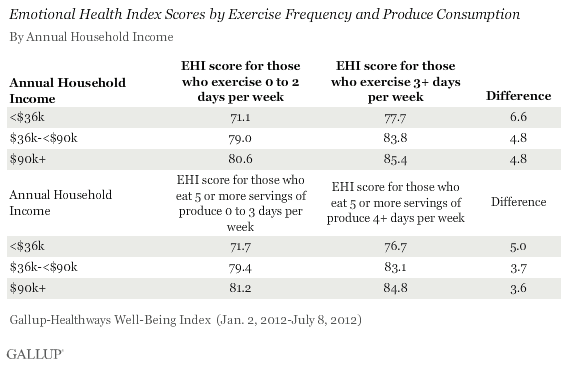WASHINGTON, D.C. -- Although all Americans report better emotional health when they exercise frequently and eat fruits and vegetables regularly, low-income Americans experience an even bigger emotional boost from practicing these good health habits than do those at higher income levels.

These findings are based on 180,299 interviews with American adults conducted between Jan. 2 and July 8, 2012, as a part of the Gallup-Healthways Well-Being Index. The Emotional Health Index score is based on Americans' self-reports of positive and negative daily emotions, as well as self-reported clinical diagnoses of depression. Specifically, Americans are asked whether they felt or did "a lot of" each of the following the day before the survey: smiling/laughing, learning/doing something interesting, being treated with respect, enjoyment, happiness, worry, sadness, anger, and stress.
Low-income Americans experience greater improvement across almost all of the items in the Emotional Health Index when they exercise frequently and eat produce regularly than do those who are at a higher income level. For example, low-income adults who exercise three or more days per week are about seven percentage points more likely than their counterparts who exercise less than that to report experiencing happiness "a lot of the day yesterday." This compares to about a four-percentage-point increase for high-income adults who exercise frequently versus those who don't. Low-income Americans experience a bigger exercise "bonus" than do those with higher incomes in terms of daily smiling and laughter, enjoyment, and happiness.
Low-income Americans who exercise frequently also see a greater reduction in daily sadness and clinical diagnoses of depression than do those with higher incomes. However, Americans who exercise frequently at all income levels see an equal decrease is daily worry, and it is actually those making $90,000 or more per year who see the greatest stress reduction from routine exercise.

Similarly, Americans in all income brackets who eat five or more servings of fruits and vegetables at least four days per week see widespread emotional health benefits, but it is particularly evident in those earning less than $36,000 per year. For example, low-income Americans who consume produce regularly are 3.9 points less likely to experience sadness "a lot of the day yesterday" than are their counterparts who don't. But, the reduction in sadness for high-income Americans who consume produce regularly is lower -- a decline of 1.9 points for those with annual incomes of $36,000 to $89,999 and -0.8 points for those making $90,000 or more per year.

Implications
Frequent exercise and healthy eating can help promote positive emotions and reduce stress levels. For low-income Americans these activities are particularly beneficial to their emotional state. They experience an increased emotional boost from exercising and healthy eating when compared to those with higher income levels, although even those who eat right and exercise routinely fail to match the emotional health of their more affluent counterparts.
It's possible that the mood-boosting side effects of exercise and healthy eating make more of a difference for those who experience more uncertainty in meeting basic needs every day. Low-income Americans also more generally report lower levels of positive emotions and higher levels of negative ones than do those with higher incomes, and thus have more room for improvement. Regardless, these results suggest that the ability to access safe places to exercise and affordable produce plays an important role in improving the emotional health of all Americans, particularly for the less wealthy.
About the Gallup-Healthways Well-Being Index
The Gallup-Healthways Well-Being Index tracks well-being in the U.S., U.K., and Germany and provides best-in-class solutions for a healthier world. To learn more, please visit well-beingindex.com.
Survey Methods
Results are based on telephone interviews conducted Jan. 2-July 8, 2012, as part of the Gallup-Healthways Well-Being Index survey with a random sample of approximately 180,299 adults, aged 18 and older, living in all 50 U.S. states and the District of Columbia, selected using random-digit-dial sampling.
For results based on the total sample of national adults, one can say with 95% confidence that the maximum margin of sampling error is ±0.3 percentage points.
Interviews are conducted with respondents on landline telephones and cellular phones, with interviews conducted in Spanish for respondents who are primarily Spanish-speaking. Each sample includes a minimum quota of 400 cell phone respondents and 600 landline respondents per 1,000 national adults, with additional minimum quotas among landline respondents by region. Landline telephone numbers are chosen at random among listed telephone numbers. Cell phone numbers are selected using random-digit-dial methods. Landline respondents are chosen at random within each household on the basis of which member had the most recent birthday.
Samples are weighted by gender, age, race, Hispanic ethnicity, education, region, adults in the household, and phone status (cell phone only/landline only/both, cell phone mostly, and having an unlisted landline number). Demographic weighting targets are based on the March 2011 Current Population Survey figures for the aged 18 and older non-institutionalized population living in U.S. telephone households. All reported margins of sampling error include the computed design effects for weighting and sample design.
In addition to sampling error, question wording and practical difficulties in conducting surveys can introduce error or bias into the findings of public opinion polls.
For more details on Gallup's polling methodology, visit https://www.gallup.com/.
